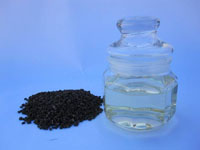Borage oil is derived from the seeds of the borage (Borago officinalis) plant, a large plant with blue, star-shaped flowers found throughout Europe and North Africa and naturalized to North America.1
Borage oil, evening primrose oil, and black currant seed oil contain gamma linolenic acid (GLA), a fatty acid that the body converts to a hormone-like substance called prostaglandin E1 (PGE1). PGE1 has anti-inflammatory properties and may also act as a blood thinner and blood vessel dilator. Linoleic acid, a common fatty acid found in nuts and seeds and most vegetable oils (including borage oil), should theoretically convert to PGE1. Many things can interfere with this conversion, however, including disease; the aging process; saturated fat; hydrogenated oils; blood sugar problems; and inadequate vitamin C, magnesium, zinc, and B vitamins. Supplements that provide GLA circumvent these conversion problems, leading to more predictable formation of PGE1.2
Borage seed oil is the richest source of GLA, containing 20 to 26%. While GLA from evening primrose oil has been widely researched, scientific evidence supporting the use of borage oil has been limited. Nonetheless, one preliminary trial3 and two double-blind trials4 5 have shown that borage oil, 1.1-2.8 grams per day for at least three months, reduces symptoms of rheumatoid arthritis.
Borage oil has also been used to treat people with atopic dermatitis (eczema) in preliminary trials, with reductions in skin inflammation, dryness, scaliness, and itch, without side effects being reported.6 However, a controlled study using 360 mg daily of GLA from borage oil in patients with atopic dermatitis (3 to 17 years of age) was unable to reproduce these results.7 In another preliminary study, a group of children with infantile seborrheic dermatitis were treated with borage oil (0.5 ml) applied to the diaper region twice daily.8 Within 10 to 12 days, all of the children were free from skin lesions, even in the areas not treated with borage. Moreover, using the oil topically two to three times a week kept the seborrhea in remission until the patients were six to seven months old. There were no relapses after the oil was discontinued.
Borage Oil
Tags:



